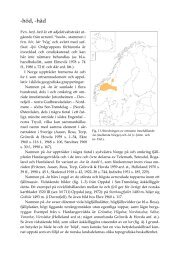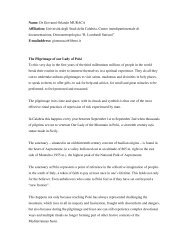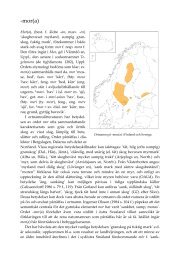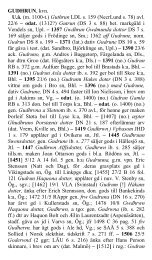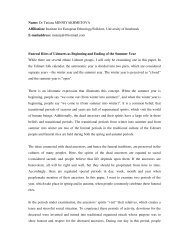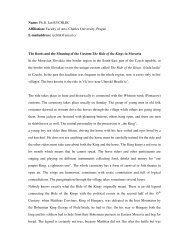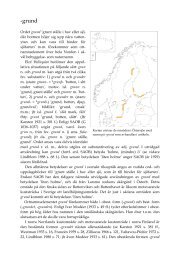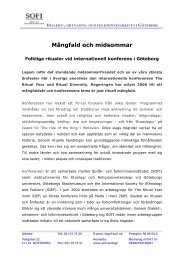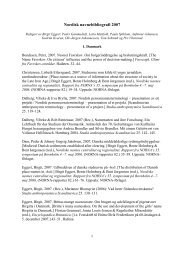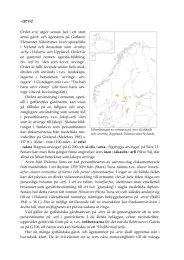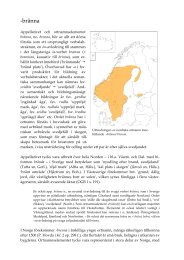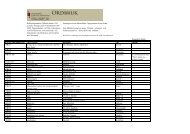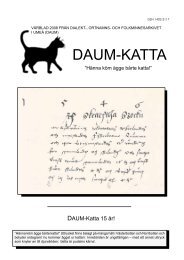Name: Ph.D. Aado LINTROP Affiliation: The Estonian Folklore ...
Name: Ph.D. Aado LINTROP Affiliation: The Estonian Folklore ...
Name: Ph.D. Aado LINTROP Affiliation: The Estonian Folklore ...
- No tags were found...
You also want an ePaper? Increase the reach of your titles
YUMPU automatically turns print PDFs into web optimized ePapers that Google loves.
<strong>Name</strong>: <strong>Ph</strong>.D. <strong>Aado</strong> <strong>LINTROP</strong><strong>Affiliation</strong>: <strong>The</strong> <strong>Estonian</strong> <strong>Folklore</strong> Archives, <strong>Estonian</strong> Literary MuseumE-mailaddress: aado@folklore.ee<strong>The</strong> midsummer prayers in the Udmurt village of Kuzebayevo.<strong>The</strong>re are two main liminal periods in the Udmurt folk calendar – the period afterwinter solstice is called vozhodyr (time of the vozho) or uivozho (night+vozho), andthe period after summer solstice invozho d+r (time of the heavenly vozho) or vozhopoton tolez’ (month of vozho emerging). <strong>The</strong> winter liminal period vozhodyr wasclearly connected with dead ancestors and evil spirits of the underworld, who weremost active at nighttime (cf. uivozho - nightvozho). Most critical time of the day wasmidnight. <strong>The</strong>re are direct references that summer liminal period was vice versarelated to heaven. G. Vereshtshagin wrote: “Old men say that during the bloomingtime of rye with vozho will join also spirits of heaven in. <strong>The</strong>se spirits constitute aspecial class of beings in Votyak mythology named Invozho. During the bloomingtime of rye they don’t like noise and drawing water from river with dirty metalvessels, especially with sooty kettles.” (Vereshtshagin 1998: 233). Restrictionsconnected with invozho dyr had to be followed especially around noon, when peopletried to make no loud noises. In some places invozho was regarded as midday spirit.In Komi mythology vezhadyr is connected with the spirit named pölödnica – possiblyconnected with the Russian creature poludnica (midday spirit) – who lived or walkedon rye field and was most active during the blooming time of rye. It is very interestingthat in Russian mythology poludnica –woman in white – forces human being tocompete with her in riddling, and tickles the loser to death. <strong>The</strong>re existed also beliefthat one of the main Udmurt deities, kyldys’in himself walked between rye fields andprotected the ripening crop, but often the guardian spirit of crop fields had namemezha ut’is’ – protector of headlands. Mezha ut’is’ reveals himself as man or womanin white.Women in the village of Kuzebayevo (Southern Udmurtia) have told the author thatduring the summer invozho–period it was forbidden to work with wool or hemp, itwas also forbidden to mow and pick flowers. In Kuzebaevo this period ended onSt. Peter’s Day (July 12 th ) with sacrificing ceremonies in great prayer cabin (byd’z’ym
kuala) and holy grove (lud). On next day the haymaking time begins. <strong>The</strong> invozho –period was often associated with the blooming of red catchfly or red campion(invozho s’as’ka).In my paper I shall treat the St. Peter’s Day’s prayers observed in the Kuzebayevovillage twice in 1980 and 2003. By means of the audiovisual material I shall bring outsome essential changes in the tradition.



